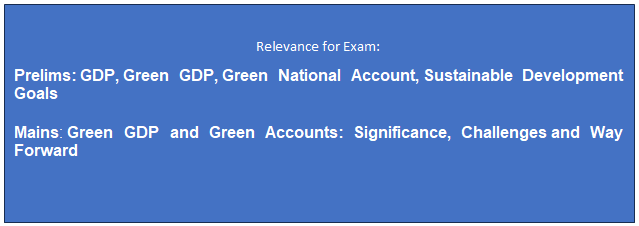- Courses
- GS Full Course 1 Year
- GS Full Course 2 Year
- GS Full Course 3 Year
- GS Full Course Till Selection
- Answer Alpha: Mains 2025 Mentorship
- MEP (Mains Enrichment Programme) Data, Facts
- Essay Target – 150+ Marks
- Online Program
- GS Recorded Course
- Polity
- Geography
- Economy
- Ancient, Medieval and Art & Culture AMAC
- Modern India, Post Independence & World History
- Environment
- Governance
- Science & Technology
- International Relations and Internal Security
- Disaster Management
- Ethics
- NCERT Current Affairs
- Indian Society and Social Issue
- NCERT- Science and Technology
- NCERT - Geography
- NCERT - Ancient History
- NCERT- World History
- NCERT Modern History
- CSAT
- 5 LAYERED ARJUNA Mentorship
- Public Administration Optional
- ABOUT US
- OUR TOPPERS
- TEST SERIES
- FREE STUDY MATERIAL
- VIDEOS
- CONTACT US
Green GDP
Green GDP
10-06-2023

About the Issue
- Recently, the growing environmental concerns has resulted in the demand for maintaining green national accounts that highlight the stock of environmental wealth, its use and depletion by the society in its conventional national accounts.
- Many activists are demanding that ‘Green GDP’ should account for both environmentally beneficial and harmful products and their social value.
- The concept of Green GDP also proposes a classification of products based on their environmental impact.
- Addition of green accounts in conventional GDP will require expansion of the definition of production, consumption, and wealth.
About GDP
-
- The GDP measures the monetary measure of all “final” goods and services— those that are bought by the final user— produced in a country in a given period.
- 4 Key “Components of GDP are”:
- All the money Indians spent for their private consumption (that is, Private Final Consumption Expenditure).
- All the money the government spent on its current consumption, such as salaries [Government Final Consumption Expenditure].
- All the money spent towards investments to boost the productive capacity of the economy. This includes business firms investing in factories or the governments building roads and bridges [Gross Fixed Capital Expenditure].
- The net effect of exports (what foreigners spent on our goods) and imports (what Indians spent on foreign goods).
- Method of Calculation: GDP = private consumption + gross investment + government investment + government spending + (exports-imports)
So, What is Green GDP and Green National Account?
- Both these concepts try to measure the economic performance of a country while taking into account the environmental costs and benefits associated with it.
- Basically, the Green GDP is an indicator that subtracts the cost of natural resource depletion and environmental degradation from the conventional GDP of a country.
- It is also known as ‘environmentally adjusted domestic product’. Green GDP shows how sustainable a country's economic growth is and how it affects the wellbeing of the public.
- While, Green National Account (GNA) is a framework that integrates environmental considerations into national accounting frameworks.
- GNA aims to measure and account for the environmental costs and benefits associated with economic activities.
- Green accounting methods attempt to calculate the value of natural resources, the costs of pollution and environmental degradation, and the benefits of ecosystem services.
Some Examples of Environmental Costs and Benefits are:
- The environmental cost refers to the bad impacts of economic activities on the environment, such as pollution, resource depletion, habitat destruction, climate change, waste generation etc.
- On the other hand, environmental benefits are the good outcomes of the economic activities on the environment, including ecosystem services (such as food provision, water purification, and climate regulation), biodiversity conservation, renewable energy adoption, sustainable agriculture practices, conservation and restoration efforts and others.
Significance of Green GDP:
-
Focus on Environmental Valuation: Green GDP include valuation of natural resources and ecosystem services, which are typically not included in traditional GDP calculations. By adding the economic value of these environmental factors, it provides a more accurate picture of the true costs and benefits of economic activities.
-
In Harmony with SDGs: The concept of Green GDP is in harmony with the Sustainable Development Goals (SDGs) by including the environmental factors in economic assessments. It allows policymakers to better understand the relation between the economic growth and environmental sustainability, which can lead to the formulation of more informed policies and strategies.
-
Quality in Policy Making: By providing a detailed picture of economic performance including the environmental dimension, the green GDP help the policymakers in prioritizing and allocating resources effectively. It also enables in the identification of sectors and activities that have significant environmental impacts.
-
Better Resource Management: Green GDP highlights the depletion of natural resources and encourages their sustainable management. By recognizing the economic value of resources, it promotes their conservation and efficient use, leading to improved resource allocation and reduced environmental degradation.
Challenges in Implementing Green GDP are:
-
Lack of Proper Data Availability: Calculating the green GDP is hard due to unreliable data on environmental costs, benefits, and natural resource value. Calculation involves assumptions and subjective judgments, which can affect reliability and comparability.
-
Difficulty in Calculating the Value of Environment: While valuing environmental goods and services in monetary terms is a contentious issue but many experts argue that certain aspects of the environment, such as biodiversity or cultural heritage, have intrinsic value that cannot be adequately captured by economic valuation methods. The process of assigning economic values to the environment can be seen as oversimplifying and commodifying the nature.
-
Tough Indicator: Green GDP is a tough indicator to calculate because it includes social, economic, and environmental factors. There's no agreed-upon method for combining these factors, and choosing the right indicators is very challenging.
-
Difficult to Turn into Policy: The concept of Green GDP is useful, but it can be hard to turn it into policies. To make policies work, we need cooperation, political support, and the strategy to overcome obstacles. Also, balancing economic growth and environmental protection is highly tricky and varies by situation, so it's tough to make universal policies based only on green GDP.
Countries that Use Green GDP are:
-
People’s Republic of China: China planned to publish Green GDP statistics in 2004 but stopped after facing political and methodological challenges following a preliminary report that showed reduced GDP growth due to environmental costs.
-
The USA: It has developed a comprehensive system of environmental-economic accounts that provide various indicators of the interactions between the economy and the environment, environmental expenditures, and environmental taxes. However, the USA does not produce a single measure of green GDP.
-
Europe: The EU requires member states to compile accounts covering emissions, taxes, materials, and protection expenditure, which can be used to calculate green GDP or adjusted domestic product.
-
Sweden: Sweden is one of the top performing countries in the Global Green Economy Index, which measures the green economy performance of 130 countries based on 4 dimensions: leadership and climate change, efficiency sectors, markets and investment, and environment and natural capital.
-
India: Green GDP is not officially measured or reported in India, but some attempts have been made to estimate it by various researchers and institutions. According to a paper published by the Reserve Bank of India in October 2022, researchers estimated the green GDP of India to be somewhere around Rs 167 trillion for 2019. This implies a reduction of about 10% from the conventional GDP of Rs 185.8 trillion for the same year.
Way Forward
-
Develop Common Framework: It’s very important to develop and adopt a common framework and methodology for measuring and valuing environmental costs and benefits, based on the best available scientific and economic understanding. Firstly, it is important to conduct pilot projects and case studies to test and refine Green GDP methodologies.
-
Data: Availability and quality of data on environmental indicators is highly required, such as data on emissions, resource use, ecosystem services, etc., and ensuring their consistency and comparability across countries.
-
Promote Awareness: It’s important to promote the awareness and understanding of green GDP among policy makers, businesses, and the public, and highlighting its advantages over conventional GDP as a measure of economic performance and social well-being.
-
Participation: Encouraging the participation and collaboration of various stakeholders, such as governments, international organizations, civil society, academia, and the private sector, in the design and implementation of green GDP policies and initiatives.
-
Conflicts: Addressing the conflicts that may arise from pursuing green GDP goals, such as balancing economic growth and environmental protection, ensuring equity and justice among different groups and regions.
Must Check: Best IAS Coaching Centre In Delhi



